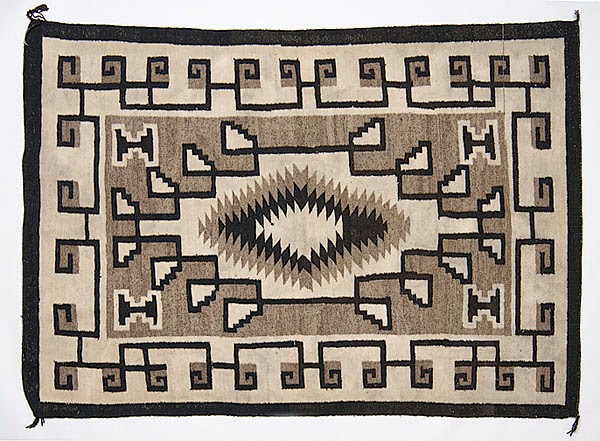I'm off to Santa Fe again, so thought I'd repost this from a visit four years ago, along with the amazing ten minute video of Navajo weaver Clara Sherman carding and spinning wool for a rug she's going to make.
April 7, 2011
I just returned from a week in Santa Fe with my husband—our fifth visit to this place so radically different from where we live that we find ourselves drawn there time and time again.
The differences are obvious; the high (more than a mile high!) desert is a stark contrast to our watery, sea-level surroundings. Where the predominant colors in the Bay Area are shades of blue-grey (as in water, fog, air and cement) and green (as in trees), Santa Fe’s palette is made up of earth tones: browns and tans, terra cotta, adobe, pale sage and a lavender taupe that is the shadow of hills. Red and turquoise are decorative accents added to homes and personal accessories the way chilies are added to spice up the hearty fare.
Over the years of visiting we have gained special appreciation for the native handcrafts, especially the beautiful woven rugs and tapestries that the Navajo women have been creating since the beginning of the 20th century. On our recent visit, we were very fortunate to catch the end of a display at the Wheelwright Museum of the American Indian; Master Weavers from the Toadlena/Two Grey Hills region. To even try to describe the exquisite intricately subtle artistry of the work shown could not do it justice. The show title best describes it; Nizhoni Shima’—“My mother, it is beautiful!”
If the video doesn't show up on your device, go to https://youtu.be/D_p7OIghMVw
If the video doesn't show up on your device, go to https://youtu.be/D_p7OIghMVw
Even more humbling is the understanding of the time dedicated to each piece; the shearing, cleaning, carding and spinning and washing alone can take up to six months and then the weaving another 6 months to a year. For a better sense of the patience, dedication and attitude around the process, watch this wonderful 10 minute video of Master Weaver Clara Sherman.
Many of the pieces have a thin line woven into the upper left hand corner that goes from the outer border to the interior of the weaving. We were told that it the spirit line—the path where Spider Woman enters the weaver and guides her through the process. A reminder for us all to leave space, leave a path that the universal creative spirit can enter to guide us in our work, whether it be weaving wool into stunning rugs or words into stories.
Take Good Care,
Take Good Care,
Sharry



good info , tnx
ReplyDelete